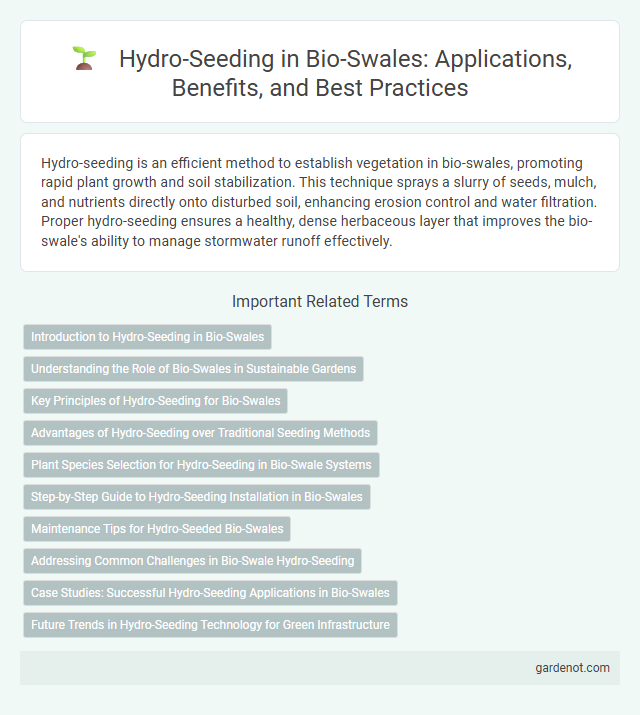Hydro-seeding is an efficient method to establish vegetation in bio-swales, promoting rapid plant growth and soil stabilization. This technique sprays a slurry of seeds, mulch, and nutrients directly onto disturbed soil, enhancing erosion control and water filtration. Proper hydro-seeding ensures a healthy, dense herbaceous layer that improves the bio-swale's ability to manage stormwater runoff effectively.
Introduction to Hydro-Seeding in Bio-Swales
Hydro-seeding in bio-swales involves spraying a slurry of seed, mulch, fertilizer, and water directly onto the soil to promote rapid vegetation growth and erosion control. This technique enhances soil stability and accelerates the establishment of native plants, which are critical for effective stormwater filtration and pollutant removal. Utilizing hydro-seeding improves bio-swale performance by creating dense, uniform vegetation that supports water infiltration and optimizes sediment capture.
Understanding the Role of Bio-Swales in Sustainable Gardens
Hydro-seeding accelerates vegetation establishment in bio-swales by evenly distributing a slurry of seed, mulch, and fertilizer, which enhances soil stabilization and erosion control. Bio-swales function as natural water filtration systems, capturing and treating stormwater runoff while promoting groundwater recharge through their permeable design. Integrating hydro-seeding with bio-swale construction optimizes plant growth, increases pollutant removal efficiency, and supports sustainable garden ecosystems.
Key Principles of Hydro-Seeding for Bio-Swales
Hydro-seeding for bio-swales relies on key principles such as selecting native, drought-tolerant seed mixtures that enhance soil stabilization and promote rapid vegetation establishment. The slurry mix includes mulch, water, seed, fertilizer, and tackifiers to ensure even seed distribution and moisture retention critical for slope adherence and erosion control. Proper application timing and slope preparation optimize seed germination and long-term bio-swale functionality in stormwater management.
Advantages of Hydro-Seeding over Traditional Seeding Methods
Hydro-seeding offers faster germination and more uniform seed distribution compared to traditional seeding methods, enhancing vegetation establishment in bio-swale projects. The mixture of seed, mulch, fertilizer, and water promotes soil moisture retention, reducing erosion and improving plant growth rates. This cost-effective technique also minimizes labor and equipment needs, making it ideal for large or difficult-to-access bio-swale areas.
Plant Species Selection for Hydro-Seeding in Bio-Swale Systems
Selecting native plant species adapted to local climate and soil conditions is crucial for hydro-seeding in bio-swale systems, as these plants enhance water absorption and pollutant filtration. Grasses like fescues and native sedges provide dense root structures that stabilize soil and reduce erosion, while wildflowers contribute to biodiversity and aesthetic appeal. Incorporating a diverse mix of deep-rooted perennials promotes long-term resilience and effective stormwater management in bio-swales.
Step-by-Step Guide to Hydro-Seeding Installation in Bio-Swales
Hydro-seeding installation in bio-swales begins with soil preparation, ensuring proper grading and loosening to enhance water infiltration and root penetration. The seed slurry, a mixture of seed, mulch, fertilizer, and water, is uniformly sprayed over the prepared bio-swale surface to promote rapid and even vegetation growth. Consistent moisture maintenance and erosion control measures are essential during the establishment phase to stabilize the bio-swale and optimize pollutant filtration.
Maintenance Tips for Hydro-Seeded Bio-Swales
Maintaining hydro-seeded bio-swales requires consistent watering to ensure seed germination and soil stabilization during the initial growth phase. Regular inspections help identify erosion or sediment buildup, allowing for timely repairs to preserve the swale's filtration and runoff control functions. Applying a light layer of mulch can enhance moisture retention and protect emerging plants from environmental stress.
Addressing Common Challenges in Bio-Swale Hydro-Seeding
Hydro-seeding in bio-swales effectively combats soil erosion and promotes rapid vegetation growth by evenly distributing seed, mulch, and fertilizer mixtures over large areas. Addressing common challenges such as uneven seed distribution and poor seed-to-soil contact involves using specialized equipment and optimizing slurry composition for enhanced moisture retention and nutrient delivery. Proper site preparation and selecting native or adaptive plant species ensure sustainable bio-swale performance and improved stormwater filtration.
Case Studies: Successful Hydro-Seeding Applications in Bio-Swales
Case studies of hydro-seeding in bio-swales demonstrate effective erosion control and rapid vegetation establishment, crucial for stormwater filtration and pollutant removal. Projects in urban settings reveal that hydro-seeding with native plant species significantly enhances soil stabilization, reduces sediment runoff, and promotes biodiversity. Data from these applications show improved water quality and increased infiltration rates, validating hydro-seeding as a cost-effective solution in bio-swale construction and maintenance.
Future Trends in Hydro-Seeding Technology for Green Infrastructure
Future trends in hydro-seeding technology for bio-swales emphasize precision application techniques that improve seed germination rates and erosion control efficiency. Advancements include the integration of drone-based spraying systems and AI-driven soil moisture monitoring to optimize seed distribution and growth conditions. Enhanced biodegradable mulch formulations are also being developed to promote sustainable green infrastructure by accelerating vegetation establishment and reducing environmental impact.
Hydro-seeding Infographic

 gardenot.com
gardenot.com